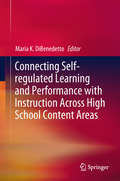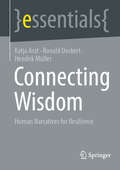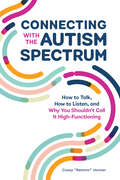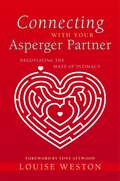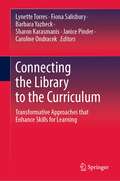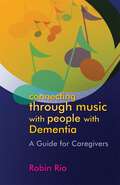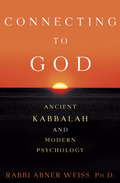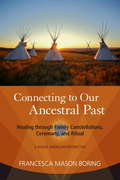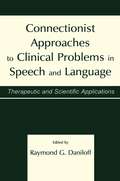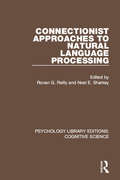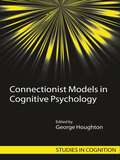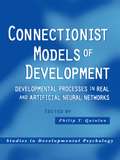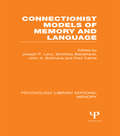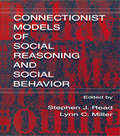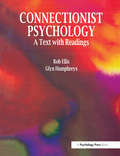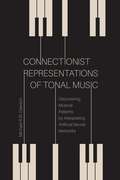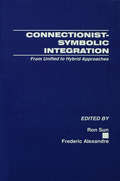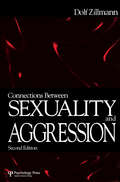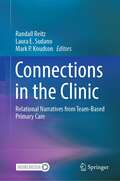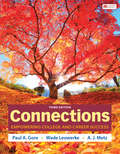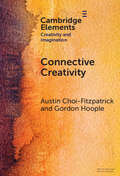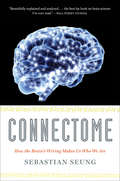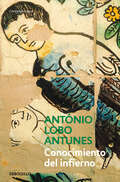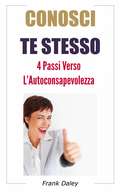- Table View
- List View
Connecting Self-regulated Learning and Performance with Instruction Across High School Content Areas
by Maria K. DiBenedettoThis book shows how principles of self-regulated learning are being implemented in secondary classrooms. The 14 chapters are theoretically driven and supported by empirical research and address all common high school content areas. The book comprises 29 lesson plans in English language arts, natural and physical sciences, social studies, mathematics, foreign language, art, music, health, and physical education. Additionally, the chapters address students with special needs, technology, and homework.Each chapter begins with one or more lesson plans written by master teachers, followed by narratives explaining how the lesson plans were implemented. The chapters conclude with an analysis written by expert researchers of the self-regulated learning elements in the lessons. Each lesson and each analysis incorporate relevant educational standards for that area. Different types of high schools in several states serve as venues.This powerful new book edited by Maria K. DiBenedetto provides a unique and invaluable resource for both secondary teachers and researchers committed to supporting adolescents in the development of academic self-regulation. Each chapter is jointly written by teachers who provide a wealth of materials, including lesson plans, and researchers who situate these lesson plans and academic self-regulation goals within the larger work on self-regulation. The topics covered are far broader than any other book I have seen in terms of developing academic self-regulation, covering over a dozen content areas, including literacy, mathematics, social studies, the sciences, and the arts. Teachers and scholars alike will find this book a must read.Karen Harris, EdD, Arizona State UniversityA practical and magnificent blend of educational research and application. This book goes beyond presenting the findings of research on self regulation by connecting detailed strategies that align with the standards to the research. DiBenedetto et al. clearly illustrate how to develop self regulated learners in the classroom. A refreshing must read for all secondary educators and educational researchers seeking to be well grounded in education research and practical application techniques. Heather Brookman, PhD, Fusion Academy- Park Avenue Self-regulated learning is a research-based process by which teachers help students realize their own role in the learning process. Connecting Self-Regulated Learning and Performance with Instruction Across High School Content Areas consists of model teachers’ lessons and analyses by prominent educational psychologists in the field of self-regulated learning. The book provides teachers with the tools needed to increase students’ awareness of learning and inspires all educators to use self-regulated learning to promote engagement, motivation, and achievement in their students. The book also provides administrators with the principles needed to infuse evidenced based self-regulated learning into their curriculum and instruction. I highly recommend the book!Marty Richburg, Northside High School
Connecting Wisdom: Human Narratives for Resilience (essentials)
by Ronald Deckert Hendrik Müller Katja ArztWe paint a comprehensive picture of human wisdom and networking, striving for a holistic understanding of resilience. To make this perspective tangible, we use narratives. These narratives encompass scientific categories of the Anthropocene, ancient stories from antiquity, and deeply personal insights. We believe that the connections of humans with nature as well as with our inner selves will be crucial to develop forward-looking attitudes. Our perception of the world determines what we see, feel, and the actions we undertake. By using legends, fairy tales, and stories of sustainability and resilience, we aim to reconnect us. The essence of wisdom lies in the courage to write our own individual narratives as a contribution to the broader picture and to listen to each other with open hearts.
Connecting With The Autism Spectrum: How To Talk, How To Listen, And Why You Shouldn't Call It High-Functioning
by Casey "Remrov" VormerThe complete guide to connecting with adults on the autism spectrum - one of the 2021 Best Books on Autism from ChoosingTherapy.comFor a friend, family member, or coworker with autism, communication can be challenging. But Connecting with the Autism Spectrum can help you find common ground with expert tips and helpful insights about talking (and listening) to neurodiverse adults so you can make your interactions more transparent, meaningful, and rewarding for all.Written by Casey Vormer, a self-taught artist and autism advocate, this comprehensive guide is a trusted source for understanding neurodiversity that features a brief introduction to the autism spectrum. It also provides easy communication strategies like active listening and positive encouragement as well as steps to avoid misunderstandings by teaching how to recognize biases and correct them. Additionally, you'll learn why the term "high functioning autism" is a misnomer to define members of this vibrant community."It's important to look at every autistic person individually and recognize their obstacles—but more importantly, we should acknowledge their skills and avoid labeling them with 'high functioning autism' or 'low functioning autism' altogether," Vormer says.Unlike other autism books, Connecting with the Autism Spectrum delivers:An easy approach—Discover the best ways to communicate with those living with autism.Situational success—Find the right information for various situations and settings, including school, work, and social relationships.A sensitive tone—Get valuable information from a clear, honest point of view that does not seek to "cure" or manipulate people.Learn how to communicate better with those on the autism spectrum with this informative book.
Connecting the Library to the Curriculum: Transformative Approaches that Enhance Skills for Learning
by Janice Pinder Lynette Torres Fiona Salisbury Barbara Yazbeck Sharon Karasmanis Caroline OndracekThis book shares the experiences of the Monash University and La Trobe University libraries in Melbourne, Australia, regarding the paths taken to transform and reposition these libraries within their institutions. The book showcases the respective frameworks used to enhance library skill development programs and addresses central topics such as partnerships, pedagogy, curriculum, emerging skill agendas and student success. It offers a theoretical and practical approach to overcoming persistent challenges and discusses several pertinent areas, e.g., establishing library-faculty partnerships, explicitly and coherently developing students’ research skills with discipline-specific content and transforming perceptions of academic libraries’ educative role. The book highlights the current issue of enhancing students’ research skills, which is forcing many academic libraries to reassess their established practices and adopt pedagogical approaches that will more readily resonate with faculty.Chapters 3 and 19 are available open access under a Creative Commons Attribution 4.0 International License via link.springer.com.
Connecting through Music with People with Dementia: A Guide for Caregivers
by Robin RioFor people with dementia, the world can become a lonely and isolated place. Music has long been a vital instrument in transcending cognitive issues; bringing people together, and allowing a person to live in the moment. Connecting through Music with People with Dementia explains how a caregiver can learn to use melody or rhythm to connect with someone who may be otherwise non-responsive, and how memories can be stimulated by music that resonates with a part of someone's past. This user-friendly book demonstrates how even simple sounds and movements can engage people with dementia, promoting relaxation and enjoyment. All that's needed to succeed is a love of music, and a desire to gain greater communication and more meaningful interaction with people with dementia. The book provides practical advice on using music with people with dementia, and includes a songbook suggesting a range of popular song choices and a chapter focusing on the importance of caregivers looking after themselves as well as the people they care for. Suitable for both family and professional caregivers with no former experience of music therapy, and for music therapy students and entry level professionals, this accessible book will lay bare the secrets of music therapy to all.
Connecting to God
by Abner WeissDistinguished rabbi, marriage and family therapist, kabbalist, and popular lecturer, Abner Weiss is extraordinarily qualified to write this book. In Connecting to God, he elucidates the teachings of Kabbalah, showing how the Ten Sefirot of the Tree of Life are the transformers of divine energy in our bodies and the building blocks of creation--Weiss calls them "our spiritual genome." He has created a psychological system and diagnostic method from kabbalistic texts, and he uses these clinically tested interventions in his therapeutic practice. Here he tells twenty-eight stories of people he has helped liberate from their dysfunctional behavior, empowering them to achieve spiritual growth. With Rabbi Weiss as our guide, we can use this kabbalistic approach to psychology to inform our lives with its insights, rebalance what is out of kilter, and heal the emotional wounds we have suffered. Connecting to God is a wise, wonderful, and transformational book.From the Hardcover edition.
Connecting to Our Ancestral Past
by Francesca Mason BoringConnecting to Our Ancestral Past is a pragmatic, spiritual journey that introduces a variety of specific rituals and conversations in connection with Constellations work, an experiential process that explores one's history and powerful events of the past in order to understand and resolve problems of the present. Constellations facilitator and author Francesca Mason Boring presents this therapeutic method in the context of cultures like the Shoshone, of which she is a member, that have seen the world through a prism of interrelationships for millennia. In Constellations work there is an organic quality that requires a discipline of non-judgment, one that is embraced in traditional native circles, where the whole truth of a person's life, roots, and trans-generational trauma or challenge is understood and included. Mason Boring provides a transformational walk through the universal indigenous field-- that place of healing and knowledge used by Native healers and teachers for centuries--by describing stories and rituals designed to help people with their particular struggles. These rituals, such as "Facing the Good Men"--designed to help women who have suffered abuse in relationships with men--reject Western notions of over-the-counter medication. Instead, they stress a comfortable environment whereby the "client," with the help of a facilitator, interacts with people chosen to represent concepts, things, and other people. In Western culture the word "medicine" is thought of as a concrete object, but Mason Boring explains that indigenous cultures favor a process of healing as opposed to an itemized substance. She re-opens doors that have been closed due to the exclusion of indigenous technology in the development of many Western healing traditions and introduces new concepts to the lexicon of Western psychology. A range of voices from around the world--leaders in the fields of systems constellations, theoretical physics, and tribal traditions--contribute to this exploration of aboriginal perspectives that will benefit facilitators of Constellations work, therapists, and human beings who are trying to walk with open eyes and hearts.
Connectionist Approaches To Clinical Problems in Speech and Language: Therapeutic and Scientific Applications
by Raymond G. DaniloffConnectionist accounts of language acquisition, processing, and dissolution proliferate despite attacks from some linguists, cognitive scientists, and engineers. Although the networks of exquisitely interconnected perceptrons postulated by PDP theorists may not be anatomically homologous with actual brain anatomy, a growing body of research suggests that the posited network functions can support many human behaviors. This volume brings together contributors with a variety of backgrounds and perspectives to explore, for the first time, the clinical implications of whole-language connectionist models. Demonstrating that these models are powerful and have explained many phenomena of language acquisition, language therapy, and speech processing, especially at the engineering level, they focus specifically on applications of connectionist theory to delayed language, aphasia, phonological acquisition, and speech perception. Connectionist models, they conclude, offer a new interpretive framework for the discussion of information processing in humans and other animals that will be of great utility to all those who study language and seek to intervene in language disorders.
Connectionist Approaches to Natural Language Processing (Psychology Library Editions: Cognitive Science)
by Ronan G. Reilly Noel E. SharkeyOriginally published in 1992, when connectionist natural language processing (CNLP) was a new and burgeoning research area, this book represented a timely assessment of the state of the art in the field. It includes contributions from some of the best known researchers in CNLP and covers a wide range of topics. The book comprises four main sections dealing with connectionist approaches to semantics, syntax, the debate on representational adequacy, and connectionist models of psycholinguistic processes. The semantics and syntax sections deal with a variety of approaches to issues in these traditional linguistic domains, covering the spectrum from pure connectionist approaches to hybrid models employing a mixture of connectionist and classical AI techniques. The debate on the fundamental suitability of connectionist architectures for dealing with natural language processing is the focus of the section on representational adequacy. The chapters in this section represent a range of positions on the issue, from the view that connectionist models are intrinsically unsuitable for all but the associationistic aspects of natural language, to the other extreme which holds that the classical conception of representation can be dispensed with altogether. The final section of the book focuses on the application of connectionist models to the study of psycholinguistic processes. This section is perhaps the most varied, covering topics from speech perception and speech production, to attentional deficits in reading. An introduction is provided at the beginning of each section which highlights the main issues relating to the section topic and puts the constituent chapters into a wider context.
Connectionist Models in Cognitive Psychology (Studies in Cognition)
by George HoughtonConnectionist Models in Cognitive Psychology is a state-of-the-art review of neural network modelling in core areas of cognitive psychology including: memory and learning, language (written and spoken), cognitive development, cognitive control, attention and action. The chapters discuss neural network models in a clear and accessible style, with an emphasis on the relationship between the models and relevant experimental data drawn from experimental psychology, neuropsychology and cognitive neuroscience. These lucid high-level contributions will serve as introductory articles for postgraduates and researchers whilst being of great use to undergraduates with an interest in the area of connectionist modelling.
Connectionist Models of Development: Developmental Processes in Real and Artificial Neural Networks (Studies in Developmental Psychology)
by Philip T. QuinlanConnectionist Models of Development is an edited collection of essays on the current work concerning connectionist or neural network models of human development. The brain comprises millions of nerve cells that share myriad connections, and this book looks at how human development in these systems is typically characterised as adaptive changes to the strengths of these connections. The traditional accounts of connectionist learning, based on adaptive changes to weighted connections, are explored alongside the dynamic accounts in which networks generate their own structures as learning proceeds.Unlike most connectionist accounts of psychological processes which deal with the fully-mature system, this text brings to the fore a discussion of developmental processes. To investigate human cognitive and perceptual development, connectionist models of learning and representation are adopted alongside various aspects of language and knowledge acquisition. There are sections on artificial intelligence and how computer programs have been designed to mimic the development processes, as well as chapters which describe what is currently known about how real brains develop.This book is a much-needed addition to the existing literature on connectionist development as it includes up-to-date examples of research on current controversies in the field as well as new features such as genetic connectionism and biological theories of the brain. It will be invaluable to academic researchers, post-graduates and undergraduates in developmental psychology and those researching connectionist/neural networks as well as those in related fields such as psycholinguistics.
Connectionist Models of Memory and Language (Psychology Library Editions: Memory)
by Paul Cairns Joseph P. Levy Dimitrios Bairaktaris John A. BullinariaConnectionist modelling and neural network applications had become a major sub-field of cognitive science by the mid-1990s. In this ground-breaking book, originally published in 1995, leading connectionists shed light on current approaches to memory and language modelling at the time. The book is divided into four sections: Memory; Reading; Computation and statistics; Speech and audition. Each section is introduced and set in context by the editors, allowing a wide range of language and memory issues to be addressed in one volume. This authoritative advanced level book will still be of interest for all engaged in connectionist research and the related areas of cognitive science concerned with language and memory.
Connectionist Models of Social Reasoning and Social Behavior
by Lynn C. Miller Stephen J. ReadAlthough neural network models have had a dramatic impact on the cognitive and brain sciences, social psychology has remained largely unaffected by this intellectual explosion. The first to apply neural network models to social phenomena, this book includes chapters by nearly all of the individuals currently working in this area. Bringing these various approaches together in one place, it allows readers to appreciate the breadth of these approaches, as well as the theoretical commonality of many of these models. The contributors address a number of central issues in social psychology and show how these kinds of models provide insight into many classic issues. Many chapters hint that this approach provides the seeds of a theoretical integration that the field has lacked. Each chapter discusses an explicit connectionist model of a central problem in social psychology. Since many of the contributors either use a standard architecture or provide a computer program, interested readers, with a little work, should be able to implement their own variations of models. Chapters are devoted to the following topics and models: * the learning and application of social categories and stereotypes; * causal reasoning, social explanation, and person perception; * personality and social behavior; * classic dissonance phenomena; and * belief change and the coherence of large scale belief systems.
Connectionist Psychology: A Textbook with Readings
by Rob Ellis G.W. HumphreysThis textbook provides an introduction and review of connectionist models applied to psychological topics. Chapters include basic reviews of connectionist models, their properties and their attributes. The application of these models to the domains of perception, memory, attention, word processing, higher language processing, and cognitive neuropsychology is then reviewed.
Connectionist Representations of Tonal Music: Discovering Musical Patterns by Interpreting Artifical Neural Networks
by Michael R. DawsonPreviously, artificial neural networks have been used to capture only the informal properties of music. However, cognitive scientist Michael Dawson found that by training artificial neural networks to make basic judgments concerning tonal music, such as identifying the tonic of a scale or the quality of a musical chord, the networks revealed formal musical properties that differ dramatically from those typically presented in music theory. For example, where Western music theory identifies twelve distinct notes or pitch-classes, trained artificial neural networks treat notes as if they belong to only three or four pitch-classes, a wildly different interpretation of the components of tonal music. Intended to introduce readers to the use of artificial neural networks in the study of music, this volume contains numerous case studies and research findings that address problems related to identifying scales, keys, classifying musical chords, and learning jazz chord progressions. A detailed analysis of the internal structure of trained networks could yield important contributions to the field of music cognition.
Connectionist-Symbolic Integration: From Unified to Hybrid Approaches
by Ron Sun Frederic AlexandreA variety of ideas, approaches, and techniques exist -- in terms of both architecture and learning -- and this abundance seems to lead to many exciting possibilities in terms of theoretical advances and application potentials. Despite the apparent diversity, there is clearly an underlying unifying theme: architectures that bring together symbolic and connectionist models to achieve a synthesis and synergy of the two different paradigms, and the learning and knowledge acquisition methods for developing such architectures. More effort needs to be extended to exploit the possibilities and opportunities in this area. This book is the outgrowth of The IJCAI Workshop on Connectionist-Symbolic Integration: From Unified to Hybrid Approaches, held in conjunction with the fourteenth International Joint Conference on Artificial Intelligence (IJCAI '95). Featuring various presentations and discussions, this two-day workshop brought to light many new ideas, controversies, and syntheses which lead to the present volume. This book is concerned with the development, analysis, and application of hybrid connectionist-symbolic models in artificial intelligence and cognitive science. Drawing contributions from a large international group of experts, it describes and compares a variety of models in this area. The types of models discussed cover a wide range of the evolving spectrum of hybrid models, thus serving as a well-balanced progress report on the state of the art. As such, this volume provides an information clearinghouse for various proposed approaches and models that share the common belief that connectionist and symbolic models can be usefully combined and integrated, and such integration may lead to significant advances in understanding intelligence.
Connections Between Sexuality and Aggression
by Dolf ZillmannThis is the only available comprehensive monograph on interrelations and interdependencies between agonistic and sexual behaviors. Integrating theory and research from biology, anthropology, neurophysiology, endocrinology, psychophysiology, and psychology, this book focuses on the mechanisms that govern the mutual influences between sexuality and aggression in behavior sequences and especially in admixtures of aggressive-sexual behaviors. This book places human agonistic and sexual behaviors into an evolutionary context. It offers a Weltbild of human aggressive-sexual behaviors by tracing their biological and developmental origins and examines the plasticity and manipulability of connections between agonistic and sexual behaviors. Strategies for the maximization of sexual pleasures are elaborated , and intervention treatments--aiming at the control of violent behaviors--are considered. Coercive sexuality is given special attention. Prevalent motive ascriptions to rape are called into question and the motivation that dominates rape is reinterpreted in the context of pleasure maximization. This second edition brings the coverage of pertinent research up to date. It advances the exploration of aggressive-sexual behaviors by further integrating the research contributions from various disciplines, and by refining and unifying theory capable of explaining the behavioral phenomena under consideration. COPY FOR ZILLMANN MAILER Zillmann examines issues such as sexual access through aggression, the involvement of agonistic behavior within sexuality, sex-aggression fusion, the consequences of anticipatory imagination concerning sexuality, and aspects of libido loss due to excitatory habituation. This book also: * traces connection between sexuality and aggression in nonhuman species, especially in nonhuman primates, * subjects human behavior to comparative and evolutionary analysis, * examines connectedness in neurological and endocrinological terms, * details both central and autonomic commonalities between sexual and aggressive behaviors, * outlines sexual dimorphism and chromosomal-endocrine aberrations, * pays special attention to adrenal commonalities in sexual and aggressive behaviors and the fusion of these behaviors, and * examines aggressive-sexual connectedness in the analysis of motivation and emotion. Zillmann finally proposes new explanations for the numerous documented associations between sexuality and aggression. These proposals combine biological, neuroendocrine, autonomic, and cognitive aspects of aggressive and sexual behaviors. A trichotomy of excitatory interdependencies is developed for fight, flight, and coition. In the nomenclature of emotion, this trichotomy concerns the interdependencies between aggressiveness, fear, and sexual impulsion. A considerable amount of research evidence is aggregated in support of these interdependencies. The author ultimately examines the exploitation of the existing connections between sexual and aggressive behaviors, especially the exploitation that serves the enhancement of sexual pleasure. In this context he arrives at novel, and perhaps distressing, characterizations of sexual coercion. However, he also explores sexual boredom and discusses remedies in the framework of his theorizing. Last but not least, sexual aggression, and sexual and aggressive behaviors independently, are placed into an evolutionary context. Recognition and acknowledgment of the archaic nature of many aspects of sexual and aggressive behaviors, in contrast to the comparatively vernal development of behavior-guiding contemplation, leads him to a unique and provocative proposal of the function of aggression in the realm of sexuality.
Connections in the Clinic: Relational Narratives from Team-Based Primary Care
by Randall Reitz Laura E. Sudano Mark P. KnudsonThis book assembles many of the foremost writers and clinicians in the field of team-based primary care to share their own relational reflections. It features narratives from fields such as integrated behavioral health, integrated primary care, primary care behavioral health, medical family therapy, health psychology, primary care psychology, and clinical social work. The key focus of the chapters are the relationships that are formed during primary care delivery. The book is organized into six core chapters: Family of Origin, Teachers and Mentors, Our Patients and Ourselves, Colleagues and Collaborators, Clinician as Patient, and Death and Loss. Each chapter contains a variety of styles and formats of narrative medicine, including personal reflections, story-telling, and poetry. Connections in the Clinic will be of interest to a wide audience of clinicians and educators dedicated to a reflective or story-telling approach to healing.
Connections: Empowering College and Career Success
by Paul A. Gore Wade Leuwerke A. J. MetzWritten by counseling psychologists Paul Gore, Wade Leuwerke, and A.J. Metz, Connections shows students from day one how to develop the mindset, drive, and strengths needed on their way to college, personal, and career success. The expertly designed program is firmly rooted in current research in positive psychology, using self-reflection as a tool for goal-setting; goal-setting as a tool for imagining one's potential; and imagining one's potential as the motivation for realizing it. Connections puts students at the center of their own personalized learning path, facilitates their purposeful choice of an academic and career plan, and develops all the skills they need--cognitive and non-cognitive, academic and life--to foster their self-growth and success.The thoroughly updated new edition addresses current challenges and research, including the growth of online learning (Appendix: Online Learning), diversity and inclusion (revised Chapter 11: Social Belonging), and the science of learning (revised Chapter 5: Understanding Thinking and Learning). These updates are reflected in a new version of ACES—the powerful, state-of-the-art student self-assessment the authors revised concurrently with Connections.
Connective Creativity: What Art Can Teach Us about Collaboration (Elements in Creativity and Imagination)
by Austin Choi-Fitzpatrick Gordon HoopleThe story we often tell about artists is fiction. We tend to imagine the starving artists toiling alone in their studio when, in fact, creativity and imagination are often relational and communal. Through interviews with artistic collectives and first-hand experience building large scale installations in public spaces and at art events like Burning Man, Choi-Fitzpatrick and Hoople take the reader behind the scenes of a rather different art world. Connective Creativity leverages these experiences to reveal what artists can teach us about collaboration and teamwork and focuses in particular on the importance of embracing playfulness, cultivating a bias for action, and nurturing a shared identity. This Element concludes with an invitation to apply lessons from the arts to promote connective creativity across all our endeavors, especially to the puzzle of how we can foster more connective creativity with other minds, including other artificial actors.
Connectome: How the Brain's Wiring Makes Us Who We Are
by Sebastian Seung&“Accessible, witty . . . an important new researcher, philosopher and popularizer of brain science . . . on par with cosmology&’s Brian Greene and the late Carl Sagan&” (The Plain Dealer). One of the Wall Street Journal&’s 10 Best Nonfiction Books of the Year and a Publishers Weekly &“Top Ten in Science&” Title Every person is unique, but science has struggled to pinpoint where, precisely, that uniqueness resides. Our genome may determine our eye color and even aspects of our character. But our friendships, failures, and passions also shape who we are. The question is: How? Sebastian Seung is at the forefront of a revolution in neuroscience. He believes that our identity lies not in our genes, but in the connections between our brain cells—our particular wiring. Seung and a dedicated group of researchers are leading the effort to map these connections, neuron by neuron, synapse by synapse. It&’s a monumental effort, but if they succeed, they will uncover the basis of personality, identity, intelligence, memory, and perhaps disorders such as autism and schizophrenia. Connectome is a mind-bending adventure story offering a daring scientific and technological vision for understanding what makes us who we are, as individuals and as a species. &“This is complicated stuff, and it is a testament to Dr. Seung&’s remarkable clarity of exposition that the reader is swept along with his enthusiasm, as he moves from the basics of neuroscience out to the farthest regions of the hypothetical, sketching out a spectacularly illustrated giant map of the universe of man.&” —TheNew York Times &“An elegant primer on what&’s known about how the brain is organized and how it grows, wires its neurons, perceives its environment, modifies or repairs itself, and stores information. Seung is a clear, lively writer who chooses vivid examples.&” —TheWashington Post
Conocimiento del infierno
by António Lobo AntunesConocimiento del infierno retrata el mundo de los locos y de su angustia sin remedio. Un mundo cercano a nosotros, sumiso y apático, que António Lobo Antunes enmarca en los pasillos de un psiquiátrico de Lisboa. Conocimiento del infierno penetra en los huesos y en la carne de las mudas y tristes criaturas que habitan esos espacios sin noche ni día, criaturas sin derechos ni esperanzas. Haciendo uso de la antigua solidaridad de los hombres, António Lobo Antunes rompe todas las ataduras a la soledad de esos locos, asumiendo su voz ausente. Con esta novela se lleva a cabo una crítica aguda sobre cierta práctica psiquiátrica, que resulta ser tan obsoleta como inhumana. António Lobo Antunes tiene el coraje de acusar a los responsables de la deshumanización de los centros psiquiátricos, y en su «conocimiento» denuncia costumbres y prácticas deleznables.
Conosci te stesso: 4 passi verso l'Auto-consapevolezza
by Frank Daley Elisabetta CarraraCONOSCERE SE STESSI: 4 PASSI VERSO L'AUTO-CONSAPEVOLEZZA Auto-consapevolezza: conoscere i vostri doni, talenti e abilità e la capacità di raggiungere il massimo attraverso essi. Se sei felice nella tua vita, non ti serve questo libro. Se no, è per te. Perché se non conosci te stesso, accadranno 3 brutte cose: *Non sarai nella giusta linea di carriera *Non sarai con la persona giusta *Non sarai felice. Non sarai contento per i primi due. Lo sai, te lo sto ricordando. Se una di queste condizioni ti riguarda, hai bisogno di questo libro. Se: *senti di voler più successo nella tua vita personale o professionale. *vuoi lasciare il tuo lavoro, ma non sai in quale ambito investirti. *scegli il compagno sbagliato (ripetutamente). *ti senti alla deriva. *stai sprecando il tuo talento in un lavoro inadatto. *pensi che le persone meno dotate di te ti siano sempre avanti nelle cose. E se: *Sei a disagio, ma non sai perché. *Sei sempre in ansia per la tua situazione. *Ti senti depresso quando pensi a dove va la tua vita. *Pensi che ci debba essere qualcosa di meglio. *Senti che stai esaurendo il tempo per fare seri cambiamenti nella tua vita. *Vuoi agire su questi sentimenti, ma non sai come. Se hai un problema serio, ma non sai cosa sia né come risolverlo. Tutto ciò finirà abbastanza velocemente e sarai esilarato nel processo! Ti sentirai meglio, svolgerai meglio i tuoi compiti guadagnando maggiore auto-consapevolezza ogni giorno. La consapevolezza di sé viene prima. Questo libro non ha la pretesa di voler rispondere a tutte le domande sul SÉ. È una introduzione al "sé", basata sul mio primo libro, "Chi sei e che cosa ci fai qui? Il modo per conoscere se stessi e ottenere quello che vuoi". Le quattro
Conquer Anxiety Workbook for Teens: Find Peace from Worry, Panic, Fear, and Phobias
by Tabatha ChansardConquer anxiety and calm your body and mind with this supportive self help book for teensAnxiety is a difficult emotion to manage, and the added stressors of teenage life can make it feel impossible to overcome. But, you have the power to handle it—you just need the right tools. Get ready to conquer anxiety with this friendly and straightforward anxiety workbook for kids and teens. The exercises inside will teach you practical, effective techniques to tackle worrying in the moment so you can keep anxiety from taking over.With this anxiety relief book, you'll find out how to identify the types of anxiety you're experiencing—general anxiety, social anxiety, panic attacks, or phobias. Then, using strategies from cognitive behavioral therapy and mindfulness, you'll learn how to manage your thoughts, emotions, and behaviors. With helpful examples of real scenarios teenagers face at school, home, or with friends, this book is your secret weapon against anxiety in any situation.If you're in search of books for anxiety and overthinking, the Conquer Anxiety Workbook for Teens offers the best in mental health books for teens as you:Soothe your mind—Learn how anxiety plays tricks on your mind, and find out how to be more realistic and confident while correcting "thinking errors" and old beliefs.Understand your body—This anxiety book for teens includes immediate calming strategies like body scanning, taking charge of your anxious alter-ego, creating a self-care routine, and more.Write in the book—This teen anxiety workbook has lined space to invite you to answer questions, try thoughtful exercises, and take quizzes right on the page.Release stress and worry while you nurture your mental health with the Conquer Anxiety Workbook for Teens.
